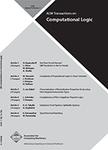版权所有:内蒙古大学图书馆 技术提供:维普资讯• 智图
内蒙古自治区呼和浩特市赛罕区大学西街235号 邮编: 010021

作者机构:Leibniz Univ Hannover Inst Theoret Informat Appelstr 9A D-30167 Hannover Germany Jonkoping Univ Sch Engn Dept Comp Sci & Informat Gjuterigatan 5 S-55111 Jonkoping Sweden
出 版 物:《ACM TRANSACTIONS ON COMPUTATIONAL LOGIC》 (美国计算机协会计算逻辑汇刊)
年 卷 期:2023年第24卷第3期
页 面:1-25页
核心收录:
学科分类:08[工学] 0701[理学-数学] 0812[工学-计算机科学与技术(可授工学、理学学位)]
基 金:German Research Foundation (DFG) [ME4279/1-2]
主 题:Parameterized complexity logic-based argumentation Schaefer's framework
摘 要:Argumentation is a well-established formalism dealing with conflicting information by generating and comparing arguments. It has been playing a major role in AI for decades. In logic-based argumentation, we explore the internal structure of an argument. Informally, a set of formulas is the support for a given claim if it is consistent, subset-minimal, and implies the claim. In such a case, the pair of the support and the claim together is called an argument. In this article, we study the propositional variants of the following three computational tasks studied in argumentation: ARG (exists a support for a given claim with respect to a given set of formulas), ARG-Check (is a given set a support for a given claim), and ARG-Rel (similarly as ARG plus requiring an additionally given formula to be contained in the support). ARG-Check is complete for the complexity class DP, and the other two problems are known to be complete for the second level of the polynomial hierarchy (Creignou et al. 2014 and Parson et al., 2003) and, accordingly, are highly intractable. Analyzing the reason for this intractability, we perform a two-dimensional classification: First, we consider all possible propositional fragments of the problem within Schaefer s framework (STOC 1978) and then study different parameterizations for each of the fragments. We identify a list of reasonable structural parameters (size of the claim, support, knowledge base) that are connected to the aforementioned decision problems. Eventually, we thoroughly draw a fine border of parameterized intractability for each of the problems showing where the problems are fixed-parameter tractable and when this exactly stops. Surprisingly, several cases are of very high intractability (para-NP and beyond).